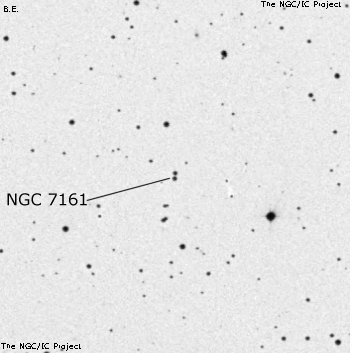NGC/IC Project Restoration Effort
(This is a very very beta version)
NGC7161


Basic Information
Location and Magnitude
Right Ascension: 21:56:57.9
Declination: +2:55:0
Constellation: PEG
Visual Magnitude:
Historic Information
Discoverer: d'Arrest
Year of discovery: 1862
Discovery aperture: 11.0
Observational
Summary description: Cl, vS, st 19, bet 2 st 16
Sub-type: *2
Corwin's Notes
=====
NGC 7161 is apparently a group of three double stars about 2 arcmin south of
d'A's position. However, his two descriptions are inconsistent, with only the
second suggesting his object is a cluster. Both descriptions mention the
10th magnitude star 11 seconds preceding the object, and both also mention the
two flanking 14th magnitude stars (though d'A puts them at 16th magnitude;
underestimating magnitudes numerically was a common occurance in the 19th
century before good photometry was available).
This object appeared first in GC thanks to a list of 125 new nebulae that d'A
sent directly to JH; thus the entry "d'Arrest, 115" in GC. D'A next published
a summary list of many of his novae in AN 1500. This object is number 194
there. Finally, when d'A's massive monograph appeared a few years later, the
full observations finally appeared.
Given the problem with the declination, I'm not completely happy with the
identification. Reinmuth called the object simply a double star, and RNGC
followed along. The brightest of the three pairs is the northern most, so I
can see why it might be taken as d'A's object. The position I give, though,
is a mean for all three -- but I'm not sure that this is the correct
interpretation. Perhaps a complete translation of d'A's Latin notes would
help.
-----
Coming across this object again in April 2016 when I have Google Translate
available, I've done the translation. Here is d'A's first observation on 13
September 1862, cleaned up to read smoothly in English, of course (the bits in
double quotes are from the original Latin text, untranslatable by me; perhaps
you can manage it):
Nebula is very faint and indistinct; very small, oblong. And there is no
moon. Verified at 231X. 2 stars 9-10 preceding; the closer star is 11
seconds preceding the nebula, somewhat south, 3 1/4' "a neb. olongata." It
is not easy to see.
The next night, d'A has this to say about it:
Very small cluster of a few stars of 19th magnitude; between 2 stars of
around 16th magnitude. Star 10-11 preceding 11 seconds. This is GC 4720.
All this leads me to doubt my earlier conclusion that the object is composed
of all three doubles. Given that d'A was using an 11-inch refractor, the
southern two pairs are probably beyond his limit. Also, he has the brighter,
preceding star "somewhat south". This would be an appropriate comment if the
brightest pair -- the northern double -- was his intended object, but would
not describe the position of the two southern pairs; those are very nearly
straight east of the star. Finally, he says "very small, oblong". This, too,
is appropriate for one, but not all three, of the pairs.
So, I am going to take just the northern double as d'A's object. Wolfgang has
done that, too. For the record, the J2000 positions of the other two pairs
are 21 56 58.2, +02 54 50 (I had previously called this "N7161: m pair") and
21 56 58.4, +02 54 26 (previously called "N7161: s pair").
Steve's Notes
=====
NGC 7161
18" (10/25/03): this is a close pair of faint mag 15 stars at 9" separation, situated nearly at the midpoint of two mag 13 stars ~2' N and 2' S. Resolved at 250x, but the faint pair appears nebulous at lower powers. Located 10' N of a distinctive equilateral triangle of stars highlighted by mag 8.9 SAO 127184.



